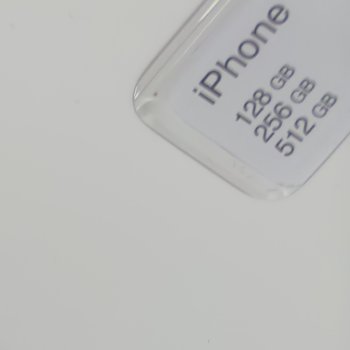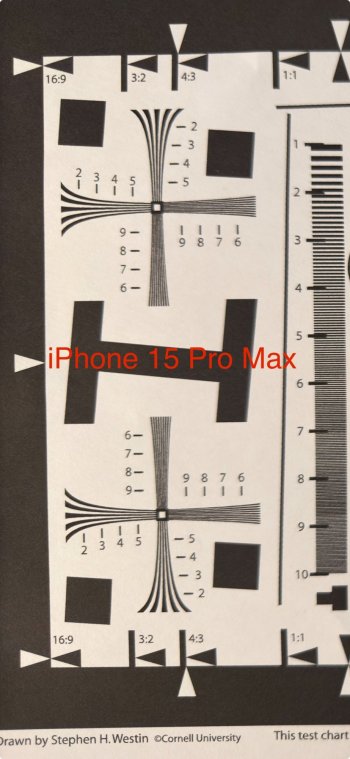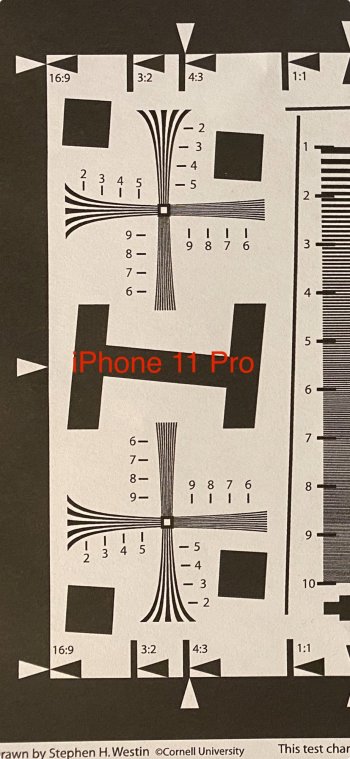I’ve been looking into this annoying issue for a bit now, I’ve compiled my personal experience, tests, and research to explain why this happens, how older iPhones compare, and how other flagship smartphones stack up. I can assure you it’s not DOF.
The Corner Softness Issue in iPhones:
The blurriness some of us notice in newer iPhones (14 Pro Max and later) is due to
corner softness. This happens when the lens struggles to maintain sharpness across the entire sensor, especially at the edges. Here’s why:
- iPhone 14 Pro Max, 15 Pro Max, 16 Pro Max:
- Main Camera: 48MP, f/1.78, 24mm, 1.22µm pixels, ~1/1.28" sensor.
- The larger 48MP sensor (~1/1.28") and smaller pixels (1.22µm vs. 1.9µm in the 13 Pro Max) demand more from the lens to resolve fine details. The lens must handle four times the detail compared to a 12MP sensor, making optical flaws like corner softness more noticeable.
- The wider 24mm focal length (vs. 26mm in older models) introduces more edge distortion, exacerbating the issue for flat subjects like text on A4 paper.
- Older iPhones (8 to 13 Pro Max):
- These models used smaller 12MP sensors, ranging from ~1/2.9" (iPhone 8, X) to ~1/1.65" (iPhone 13 Pro Max), with larger pixels (1.22µm to 1.9µm).
- The smaller sensor size and lower resolution meant the lens didn’t need to resolve as much detail, reducing optical flaws like corner softness or chromatic aberration.
- The 26mm focal length in the 11–13 Pro Max models (28mm in the 8 and X) provided a narrower field of view, minimizing edge distortion compared to the 24mm lens in newer models.
The iPhone 13 Pro Max (and older iPhones), with its 12MP sensor, 1.9µm pixels, and 26mm lens, delivers crisp, sharp text photos with minimal edge distortion—making it a benchmark for document photography.
iPhone Camera Specs Over the Years
Here’s a quick rundown of the main camera specs for context:
- iPhone 8 (2017): 12MP, f/1.8, 28mm, 1.22µm pixels, ~1/2.9" sensor.
- iPhone X (2017): 12MP, f/1.8, 28mm, 1.22µm pixels, ~1/1.9" sensor.
- iPhone 11 Pro Max (2019): 12MP, f/1.8, 26mm, 1.4µm pixels, ~1/2.55" sensor.
- iPhone 12 Pro Max (2020): 12MP, f/1.6, 26mm, 1.7µm pixels, ~1/1.7" sensor.
- iPhone 13 Pro Max (2021): 12MP, f/1.5, 26mm, 1.9µm pixels, ~1/1.65" sensor.
- Sharp, natural text rendering due to larger pixels and minimal processing.
- iPhone 14 Pro Max (2022), 15 Pro Max (2023), 16 Pro Max (2024): 48MP, f/1.78, 24mm, 1.22µm pixels (quad-pixel sensor), ~1/1.28" sensor.
- The wider 24mm lens introduces distortion at close range. Pixel binning and advanced processing (Photonic Engine, Smart HDR 5) can over-process text, softening edges or adding artifacts.
Conclusion: The larger ~1/1.28" sensor in the 14–16 Pro Max offers better light capture but requires a higher-quality lens to maintain sharpness across the frame. The mismatch between the sensor and lens contributes to corner softness, especially for text photography.
Why the 13 Pro Max takes sharper pictures
The iPhone 13 Pro Max’s 12MP sensor (1.9µm pixels) and simpler processing deliver crisp text photos with minimal computational interference. In contrast, the 14, 15, and 16 Pro Max models, with their 48MP sensors, wider 24mm lenses cause blurriness and softened edges.
The 16 Pro Max does improve overall sensor performance with a faster readout and better stabilization, but the pixel size (1.22µm) and sensor size (~1/1.28") remain unchanged from the 14 and 15 Pro Max, so the corner softness issue persists.
Workarounds for Newer iPhones
You can mitigate corner softness on the 14–16 Pro Max models with these tips:
- Use 2x Crop Mode: The 2x zoom (48mm equivalent) uses the center of the lens, avoiding the soft corners and leveraging the sharpest region.
- Optimal Distance: Shoot at 40–50 cm to reduce edge distortion.
Ultimately, Apple would need to improve the lens design—perhaps by reverting to a 26mm focal length or adding a variable aperture—to fully resolve corner softness in future models.
How Other Flagships Compare
I also looked into whether other flagship smartphones with similar high-resolution sensors (around 48MP or 50MP) face corner softness issues. Here’s what I found:
- Huawei Pura 70 Ultra:
- Main Camera: 50MP, 1-inch sensor (~13.2mm x 8.8mm), f/1.6–f/4.0 variable aperture, 23mm.
- Assessment: Some corner softness exists, especially with the ultra-wide camera, but the main camera performs better, likely due to the variable aperture and 23mm lens. The issue is less severe than the iPhone 15 Pro Max.
- Google Pixel 9 Pro XL:
- Main Camera: 50MP, 1/1.31-inch sensor (~9.7mm x 7.3mm), f/1.7, 25mm.
- Assessment: No significant corner softness reported. The 25mm lens and Google’s advanced software corrections likely mitigate the issue, making it less noticeable than in the iPhone 15 Pro Max.
- Honor Magic6 Pro:
- Main Camera: 50MP, f/1.4–f/2.0 variable aperture, 23mm, ~1/1.3" sensor (estimated).
- Assessment: Minor corner softness, mostly with the ultra-wide camera. The main camera performs well, thanks to the 23mm lens and variable aperture, making the issue less severe than in the iPhone 15 Pro Max.
- Oppo Find X8 Ultra:
- Main Camera: 50MP, 1-inch sensor (~13.1mm x 9.8mm), f/1.8, 23mm.
- Assessment: Likely has some corner softness due to the large 1-inch 50MP sensor, but reviews don’t confirm this. Oppo’s Hasselblad-tuned software may mask the issue by over-sharpening edges, making it less noticeable than in the iPhone.
General Takeaway: Corner softness is a common challenge for flagships with large, high-resolution sensors. The iPhone 15 Pro Max’s issue is more pronounced due to its 24mm lens and fixed aperture. Other flagships like the Pura 70 Ultra, Magic6 Pro, and Find X8 Ultra benefit from narrower 23mm lenses and/or variable apertures, while the Pixel 9 Pro XL stands out for avoiding the issue, likely due to Google’s software optimizations.
Final Thoughts
The iPhone 13 Pro Max remains a gold standard due to its 12MP sensor, larger 1.9µm pixels, and 26mm lens. Newer models (14–16 Pro Max) prioritize versatility with their 48MP sensors, but the larger sensor size (~1/1.28") and wider 24mm lens introduce corner softness that impacts text clarity. Apple could learn from competitors—either by adjusting the lens design (e.g., using a 26mm focal length or variable aperture) or enhancing software corrections—to fix this in future models.











